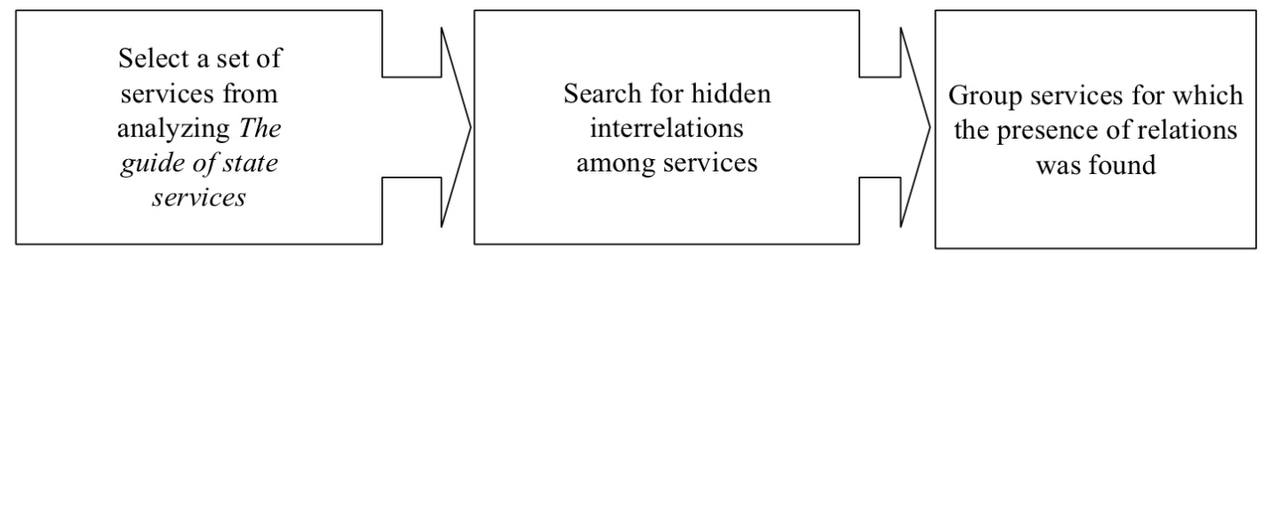Establishing the grouping principle of public services based on the analysis of similarity coefficients
DOI:
https://doi.org/10.15587/1729-4061.2023.280218Keywords:
information technology of intelligent analysis, algorithm of grouping public services, service portfolio, Jacquard similarity coefficient, Sorensen similarity coefficientAbstract
The object of this study is the process of identifying implicit relationships between public services and the process of forming portfolios and groups of services determined on the basis of the formulated principle of combining services. The task to identify groups of interconnected services, which is relevant in view of the processes of digital transformation in the field of public services, was addressed. Expanding portfolios of public services thru the formed groups of interconnected services could make it possible to better take into account the interests of users, as well as simplify the process of development and reengineering of public services. The proposed approach to form groups of services would reduce the cost and complexity of reengineering services or converting them into electronic form.
The result of research is a new principle of combining or grouping services, which is based on the methods of intelligent analysis. The basis of the proposed principle of forming groups of services is a simple and effective mathematical apparatus of applying similarity coefficients to establish the similarity of sets, which has not yet been used in the field of public services. The presence of interrelationships between services was established based on the analysis of Jaccard and Sorensen similarity coefficients. An algorithm for forming groups of services based on a new principle has been developed. The relationship between services was established as a result of the analysis of the composition of services, that is, the documents or data necessary for the provision of these services. This allows applying the proposed approach without restrictions and additional conditions. The developed algorithm also allows for «What-if» analysis of the obtained results. An illustrative example was considered: for a set of 10 services, 4 groups of services are formed. Suggestions for applying the proposed approach are provided
References
- Pro administratyvni posluhy: Zakon Ukrainy vid 06.09.2012 No. 5203-VI. Verkhovna Rada Ukrainy. Available at: https://zakon.rada.gov.ua/go/5203-17
- Pro osoblyvosti nadannia publichnykh (elektronnykh publichnykh) posluh: Zakon Ukrainy vid 15.07.2021 No. 1689-IX. Verkhovna Rada Ukrainy. Available at: https://zakon.rada.gov.ua/go/1689-20
- Persaud, A., Persaud, P. (2013). Rethinking E-Government Adoption: A User-Centered Model. International Journal of Electronic Government Research, 9 (4), 56–74. doi: https://doi.org/10.4018/ijegr.2013100104
- Gavrilenko, O., Zhurakovska, O., Kohan, A., Matviychuk, R., Piskun, A., Khavikova, Y., Khalus, O. (2022). The principle for forming a portfolio of public services based on the analysis of statistical information. Eastern-European Journal of Enterprise Technologies, 3 (3 (117)), 57–64. doi: https://doi.org/10.15587/1729-4061.2022.260136
- Gavrilenko, O., Khomenko, O., Zhurakovska, O., Kohan, A., Piskun, A., Khalus, O. (2022). Application of association rules for formation of public (administrative) services portfolio. Advanced Information Systems, 6 (4), 63–68. doi: https://doi.org/10.20998/2522-9052.2022.4.09
- Najafli, E. (2021). Understanding the concept of “digitalization” in the context of government. Law and Society, 5, 201–214. doi: https://doi.org/10.32842/2078-3736/2021.5.27
- Zhosan, H. (2020). Development of digitalization in Ukraine. Economic Analysis, 30 (1), 44–52. doi: https://doi.org/10.35774/econa2020.01.02.044
- Ivanovych, L. M. (2020). Digitalization in Ukraine: concept, problems, prospects and tasks of public administration. Naukovyi visnyk: Derzhavne upravlinnia, 2 (4), 202–213. doi: https://doi.org/10.32689/2618-0065-2020-2(4)-202-213
- Digital Economy and Society Index (DESI) 2020. Available at: https://digital-strategy.ec.europa.eu/en/library/digital-economy-and-society-index-desi-2020
- Digital Economy and Society Index 2021: overall progress in digital transition but need for new EU-wide effort. Available at: https://ec.europa.eu/commission/presscorner/detail/en/ip_21_5481
- Digitalisation in Europe 2021-2022: Evidence from the EIB Investment Survey. European Investment Bank. Available at: https://www.eib.org/en/publications/digitalisation-in-europe-2021-2022.htm
- How broadband, digitization and ICT regulation impact the global economy. Available at: https://www.itu.int/hub/publication/d-pref-ef-bdr-2020/
- Tyshchenkova, I. O. (2017). Elektronni posluhy u diyalnosti publichnoi administratsiyi Ukrainy. Dnipro: DDUVS, 156. Available at: https://er.dduvs.in.ua/bitstream/123456789/935/1/Монография_Тищенкова%20І.О.pdf
- EU4DigitalUA. Available at: https://eu4digitalua.eu/
- Hid z derzhavnykh posluh. Available at: https://guide.diia.gov.ua/
- Leskovec, J., Rajaraman, A., Ullman, J. D. (2014). Mining of Massive Datasets. Cambridge University Press. doi: https://doi.org/10.1017/cbo9781139924801
- Magurran, A. (2013). Measuring Biological Diversity. Wiley. Available at: https://www.perlego.com/book/1006601/measuring-biological-diversity-pdf

Downloads
Published
How to Cite
Issue
Section
License
Copyright (c) 2023 Olena Gavrilenko, Oleksandr Khomenko, Oksana Zhurakovska, Alla Kogan, Roman Matviichuk, Andrii Piskun, Yuliia Khavikova

This work is licensed under a Creative Commons Attribution 4.0 International License.
The consolidation and conditions for the transfer of copyright (identification of authorship) is carried out in the License Agreement. In particular, the authors reserve the right to the authorship of their manuscript and transfer the first publication of this work to the journal under the terms of the Creative Commons CC BY license. At the same time, they have the right to conclude on their own additional agreements concerning the non-exclusive distribution of the work in the form in which it was published by this journal, but provided that the link to the first publication of the article in this journal is preserved.
A license agreement is a document in which the author warrants that he/she owns all copyright for the work (manuscript, article, etc.).
The authors, signing the License Agreement with TECHNOLOGY CENTER PC, have all rights to the further use of their work, provided that they link to our edition in which the work was published.
According to the terms of the License Agreement, the Publisher TECHNOLOGY CENTER PC does not take away your copyrights and receives permission from the authors to use and dissemination of the publication through the world's scientific resources (own electronic resources, scientometric databases, repositories, libraries, etc.).
In the absence of a signed License Agreement or in the absence of this agreement of identifiers allowing to identify the identity of the author, the editors have no right to work with the manuscript.
It is important to remember that there is another type of agreement between authors and publishers – when copyright is transferred from the authors to the publisher. In this case, the authors lose ownership of their work and may not use it in any way.









